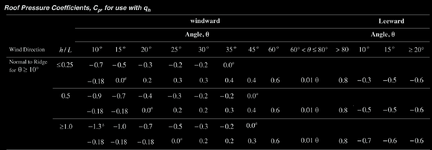Confirm the code and year when you cite code info.
ASCE 7-22
You need to clarify are you talking about one positive and one negative pressure or the ones with 2 negative pressures. Either way, it is explained either in note 3 of Figure 27.3-1 or the Commentary
This is what I've found:
"Observations in wind tunnel tests show that areas of
very low negative pressure and even
slightly positive pressure can occur in all roof structures, particularly as the distance from the windward edge increases and the wind streams reattach to the surface. These pressures can occur even for relatively flat or low-slope roof structures. Experience and judgement from wind-tunnel studies have been used to specify either zero or slightly negative pressures (-0.18) depending on the negative pressure coefficient. These
new values require the designer to consider a zero or slightly positive net wind pressure in the load combinations of Section 2."
So the -0.18 is a constant and will change when the roof slope is from 25 to 60 deg and can be 0 when it falls between 60 and 80 deg? In our study, the values we are getting is close to that of the higher value and confused where is the other. Other post I've found dated using ASCE 7-02 stated that it will be like this:
"So what does this mean? When you combine these coefficients with the internal pressure coefficients from Figure 6-5 ,you get:
for h/L = 0.5, theta = 10 degrees
for enclosed structures:
-0.9 - (-0.18) = -0.72
-0.9 - (+0.18) = -1.08
-0.18 - (-0.18) = 0.00 (new load case, the zero net pressure mentioned above)
-0.18 - (+0.18) = -0.36
For partially enclosed structures
-0.9 - (-0.55) = -1.45
-0.9 - (+0.55) = -0.35
-0.18 - (-0.55) = -0.73
-0.18 - (+0.55) = +0.37 (new load case, the slightly positve net pressure mentioned above)"


